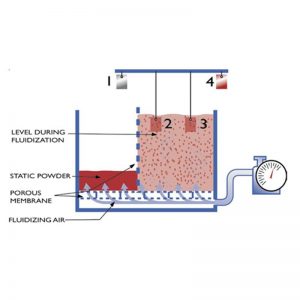What is fluidized bed?

A fluidized bed is a process that involves suspending solid particles in a fluid-like state, usually by blowing air or gas through the bottom of a container. This creates a bed of particles that are in constant motion and have the properties of both a liquid and a gas. Fluidized beds are commonly used in industrial processes such as chemical production, oil refining, and power generation.
The concept of fluidization was first discovered in the 1930s by a British engineer named Lewis Fry Richardson, who noticed that sand behaved like a liquid when it was blown by the wind. In the 1940s, German scientist Fritz Winkler developed the first fluidized bed reactor for the production of synthetic gasoline.
Fluidized beds have many advantages over conventional fixed bed reactors, including improved heat and mass transfer, increased reaction rates, and better control of temperature and pressure. The fluid-like behavior of the particles also reduces the risk of hot spots or dead zones, which can cause inefficient or incomplete reactions.
The basic design of a fluidized bed consists of a container or vessel that is filled with a solid material, typically a granular substance such as sand, limestone, or catalyst particles. Air or gas is then introduced from the bottom of the container, creating a flow of fluid that lifts and suspends the particles in the air.
As the fluid flows through the bed, it causes the particles to move and collide with each other, creating a dynamic mixing and blending effect. This motion also exposes the particles to a greater surface area, allowing for more efficient heat and mass transfer between the particles and the surrounding fluid.
One of the key advantages of fluidized beds is their ability to control the temperature of the reaction. By adjusting the flow rate and temperature of the fluid, operators can maintain a consistent temperature throughout the bed, preventing hot spots and ensuring that the reaction proceeds at an optimal rate.
Fluidized beds are commonly used in the production of chemicals, such as the production of ammonia, methanol, and other petrochemicals. They are also used in the processing of food and pharmaceuticals, as well as in the treatment of wastewater and other industrial effluents.
In the power generation industry, fluidized beds are used in the combustion of coal and other fossil fuels. The process involves burning the fuel in a fluidized bed of limestone, which reacts with the sulfur dioxide produced during combustion to form calcium sulfate (gypsum). This process, known as fluidized bed combustion, reduces the emission of sulfur dioxide and other pollutants associated with conventional coal-fired power plants.
In conclusion, fluidized beds are an innovative and versatile technology that has many industrial applications. They offer improved heat and mass transfer, increased reaction rates, and better control of temperature and pressure. They are used in a wide range of industries, including chemical production, power generation, food processing, and wastewater treatment.


Leave a Reply